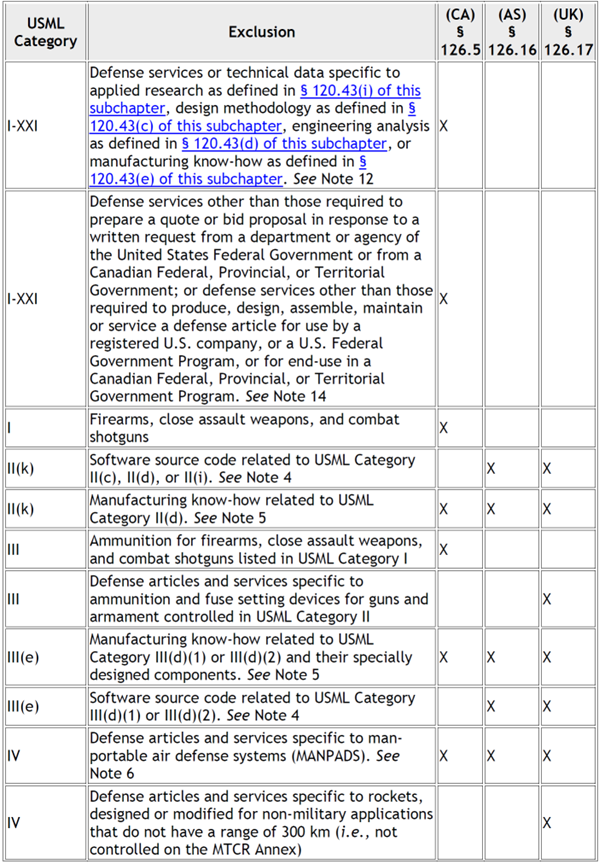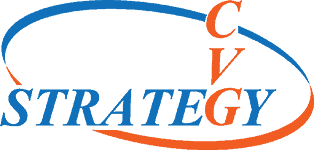ITAR Part 126 Supplement 1
CVG Supporting Statment
Supplement No. 1 to Part 126
ITAR Part 126 Supplement 1
[Supplement No. 1* – *An “X” in the chart indicates that the item is excluded from use under the exemption referenced in the top of the column. An item excluded in any one row is excluded regardless of whether other rows may contain a description that would include the item.] USML Category Exclusion (CA) § 126.5 (AS) § 126.16 (UK) § 126.17











Note 1: Classified defense articles and services are not
eligible for export under the Canadian exemptions. U.S. origin articles,
technical data, and services controlled in USML Category XVII are not eligible
for export under the UK Treaty exemption. U.S. origin classified defense
articles and services are not eligible for export under either the UK or AS
Treaty exemptions except when being released pursuant to a U.S. Department of
Defense written request, directive, or contract that provides for the export of
the defense article or service.
Note 2: The phrase “any part
of the spectrum” includes radio frequency (RF), infrared (IR), electro-optical,
visual, ultraviolet (UV), acoustic, and magnetic. Defense articles related to reduced
observables or counter reduced observables are defined as:
(a) Signature reduction
(radio frequency (RF), infrared (IR), Electro-Optical, visual, ultraviolet
(UV), acoustic, magnetic, RF emissions) of defense platforms, including
systems, subsystems, components, materials (including dual-purpose materials
used for Electromagnetic Interference (EM) reduction), technologies, and
signature prediction, test and measurement equipment and software, and material
transmissivity/reflectivity prediction codes and optimization software.
(b) Electronically scanned
array radar, high power radars, radar processing algorithms, periscope-mounted
radar systems (PATRIOT), LADAR, multistatic and IR focal plane array-based
sensors, to include systems, subsystems, components, materials, and
technologies.
Note 3: Defense articles and
services related to sensor fusion beyond that required for display or
identification correlation is defined as techniques designed to automatically
combine information from two or more sensors/sources for the purpose of target
identification, tracking, designation, or passing of data in support of
surveillance or weapons engagement. Sensor fusion involves sensors such as
acoustic, infrared, electro optical, frequency, etc. Display or identification
correlation refers to the combination of target detections from multiple
sources for assignment of common target track designation.
Note 4: Software source code
beyond that source code required for basic operation, maintenance, and training
for programs, systems, and/or subsystems is not eligible for use of the UK or
AS Treaty exemptions, unless such export is pursuant to a written solicitation
or contract issued or awarded by the U.S. Department of Defense for an end-use
identified in paragraph (e)(1), (e)(2), or (e)(4) of § 126.16 or § 126.17 of
this subchapter and is consistent with other exclusions of this supplement.
Note 5: Manufacturing
know-how, as defined in § 120.43(g) of this subchapter, is not eligible for use
of the UK or AS Treaty exemptions, unless such export is pursuant to a written
solicitation or contract issued or awarded by the U.S. Department of Defense
for an end-use identified in paragraph (e)(1), (2), or (4) of § 126.16 or §
126.17 of this subchapter and is consistent with other exclusions of this
supplement.
Note
6: Defense articles and services specific to Man Portable Air Defense Systems (MANPADS)
includes missiles that can be used without modification in other applications.
It also includes production and test equipment and components specifically
designed or modified for MANPAD systems, as well as training equipment
specifically designed or modified for MANPAD systems.
Note 7: Naval nuclear
propulsion plants includes all of USML Category VI(e). Naval nuclear propulsion
information consists of technical data that concern the design, arrangement,
development, manufacture, testing, operation, administration, training,
maintenance, and repair of the propulsion plants of naval nuclear-powered ships
and prototypes, including the associated shipboard and shore-based nuclear
support facilities. Examples of defense articles covered by this exclusion
include nuclear propulsion plants and nuclear submarine technologies or
systems; nuclear powered vessels (see USML Categories VI and XX).
Note 8: A complete gas
turbine engine with embedded hot section components or digital engine controls
is eligible for export or transfer under the Treaties. Technical data, other
than those data required for routine external maintenance and operation,
related to the hot section is not eligible for export under the Canadian
exemption. Technical data, other than those data required for routine external
maintenance and operation, related to the hot section or digital engine
controls, as well as individual hot section parts or components are not
eligible for the Treaty exemption whether shipped separately or accompanying a complete
engine. Gas turbine engine hot section exempted defense article components and
technology are combustion chambers and liners; high pressure turbine blades,
vanes, disks and related cooled structure; cooled low pressure turbine blades,
vanes, disks and related cooled structure; cooled augmenters; and cooled
nozzles. Examples of gas turbine engine hot section developmental technologies
are Integrated High Performance Turbine Engine Technology (IHPTET), Versatile,
Affordable Advanced Turbine Engine (VAATE), and Ultra-Efficient Engine
Technology (UEET), which are also excluded from export under the exemptions.
Note 9: Examples of
countermeasures and counter-countermeasures related to defense articles not
exportable under the AS or UK Treaty exemptions are:
(a) IR countermeasures;
(b) Classified techniques and
capabilities;
(c) Exports for precision
radio frequency location that directly or indirectly supports fire control and
is used for situation awareness, target identification, target acquisition, and
weapons targeting and Radio Direction Finding (RDF) capabilities. Precision RF
location is defined as angle of arrival accuracy of less than five degrees
(RMS) and RF emitter location of less than ten percent range error;
(d) Providing the capability
to reprogram; and
(e) Acoustics (including
underwater), active and passive countermeasures, and counter-countermeasures
Note 10: Examples of defense
articles covered by this exclusion include underwater acoustic vector sensors;
acoustic reduction; off-board, underwater, active and passive sensing,
propeller/propulsor technologies; fixed mobile/floating/powered detection
systems which include in-buoy signal processing for target detection and
classification; autonomous underwater vehicles capable of long endurance in
ocean environments (manned submarines excluded); automated control algorithms
embedded in on-board autonomous platforms which enable (a) group behaviors for
target detection and classification, (b) adaptation to the environment or
tactical situation for enhancing target detection and classification;
“intelligent autonomy” algorithms that define the status, group (greater than
2) behaviors, and responses to detection stimuli by autonomous, underwater
vehicles; and low frequency, broad band “acoustic color,” active acoustic
“fingerprint” sensing for the purpose of long range, single pass identification
of ocean bottom objects, buried or otherwise (controlled under Category USML
XI(a)(1), (a)(2), (b), (c), and (d)).
Note 11: This exclusion does
not apply to the platforms (e.g., vehicles) for which the armored plates are
applied. For exclusions related to the platforms, refer to the other exclusions
in this list, particularly for the category in which the platform is
controlled.
The excluded defense articles
include constructions of metallic or non-metallic materials or combinations
thereof specially designed to provide protection for military systems. The
phrase “suitable for military use” applies to any articles or materials which
have been tested to level IIIA or above IAW NIJ standard 0108.01 or comparable
national standard. This exclusion does not include military helmets, body
armor, or other protective garments which may be exported IAW the terms of the
AS or UK Treaty.
Note 12: Defense services or
technical data specific to applied research (§ 120.43(i) of this subchapter),
design methodology (§ 120.43(c) of this subchapter), engineering analysis (§
120.43(d) of this subchapter), or manufacturing know-how (§ 120.43(e) of this
subchapter) are not eligible for export under the Canadian exemptions. However,
this exclusion does not include defense services or technical data specific to
build-to-print as defined in § 120.43(f) of this subchapter,
build/design-to-specification as defined in § 120.43(g) of this subchapter, or
basic research as defined in § 120.43(h) of this subchapter, or maintenance
(i.e., inspection, testing, calibration or repair, including overhaul,
reconditioning and one-to-one replacement of any defective items parts or
components, but excluding any modification, enhancement, upgrade or other form
of alteration or improvement that changes the basic performance of the item) of
non-excluded defense articles which may be exported subject to other exclusions
or terms of the Canadian exemptions.
Note 13: The term “libraries”
(parametric technical databases) means a collection of technical information of
a military nature, reference to which may enhance the performance of military
equipment or systems.
Note 14: In order to utilize
the authorized defense services under the Canadian exemption, the following
must be complied with:
(a) The Canadian contractor
and subcontractor must certify, in writing, to the U.S. exporter that the
technical data and defense services being exported will be used only for an
activity identified in Supplement No. 1 to part 126 of this subchapter and in
accordance with § 126.5 of this subchapter; and
(b) A written arrangement
between the U.S. exporter and the Canadian recipient must:
(1) Limit delivery of the
defense articles being produced directly to an identified manufacturer in the
United States registered in accordance with part 122 of this subchapter; a
department or agency of the United States Federal Government; a
Canadian-registered person authorized in writing to manufacture defense
articles by and for the Government of Canada; a Canadian Federal, Provincial,
or Territorial Government;
(2) Prohibit the disclosure
of the technical data to any other contractor or subcontractor who is not a
Canadian-registered person;
(3) Provide that any
subcontract contain all the limitations of § 126.5 of this subchapter;
(4) Require that the Canadian
contractor, including subcontractors, destroy or return to the U.S. exporter in
the United States all of the technical data exported pursuant to the contract
or purchase order upon fulfillment of the contract, unless for use by a
Canadian or United States Government entity that requires in writing the
technical data be maintained. The U.S. exporter must be provided written
certification that the technical data is being retained or destroyed; and
(5) Include a clause
requiring that all documentation created from U.S. origin technical data
contain the statement that, “This document contains technical data, the use of
which is restricted by the U.S. Arms Export Control Act. This data has been
provided in accordance with, and is subject to, the limitations specified in §
126.5 of the International Traffic in Arms Regulations (ITAR). By accepting
this data, the consignee agrees to honor the requirements of the ITAR.”
(c) The U.S. exporter must
provide the Directorate of Defense Trade Controls a semi-annual report
regarding all of their on-going activities authorized under § 126.5 of this
subchapter. The report shall include the article(s) being produced; the
end-user(s); the end-item into which the product is to be incorporated; the intended
end-use of the product; and the names and addresses of all the Canadian
contractors and subcontractors.
Note 15: This exclusion does
not apply to demining equipment in support of the clearance of landmines and
unexploded ordnance for humanitarian purposes.
As used in this exclusion,
“anti-personnel landmine” means any mine placed under, on, or near the ground
or other surface area, or delivered by artillery, rocket, mortar, or similar
means or dropped from an aircraft and which is designed to be detonated or
exploded by the presence, proximity, or contact of a person; any device or
material which is designed, constructed, or adapted to kill or injure and which
functions unexpectedly when a person disturbs or approaches an apparently
harmless object or performs an apparently safe act; any manually-emplaced
munition or device designed to kill, injure, or damage and which is actuated by
remote control or automatically after a lapse of time.
Note 16: The radar systems
described are controlled in USML Category XI(a)(3)(i) through (v). As used in
this entry, the term “systems” includes equipment, devices, software,
assemblies, modules, components, practices, processes, methods, approaches,
schema, frameworks, and models.
Note 17: This exclusion does
not apply to the export of defense articles previously notified to Congress
pursuant to § 123.15 or § 124.11 of this subchapter. For use of the Australian
and UK exemptions for congressional notification, see § 126.16 and § 126.17
[79 FR 77885, Dec. 29, 2014;
as amended at 87 FR 16425, Mar. 23, 2022
How Can We Help?
CVG Strategy provides expertise to businesses in Quality Management, Product Test and Evaluation, Cybersecurity, and Export Compliance. Learn more about how we can help your organization by contacting us today.
Latest News
Global Challenges for Cybersecurity Resilience
Global challenges for cybersecurity resilience were outlined in a recent report from the World Economic Forum. The report, Global Cybersecurity Outlook 2024, analyzes the state of


